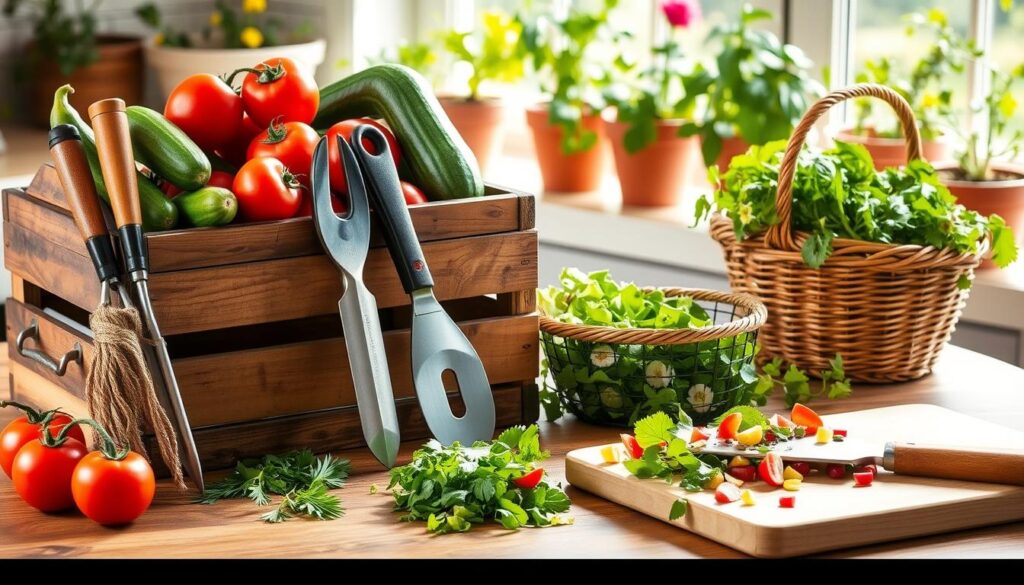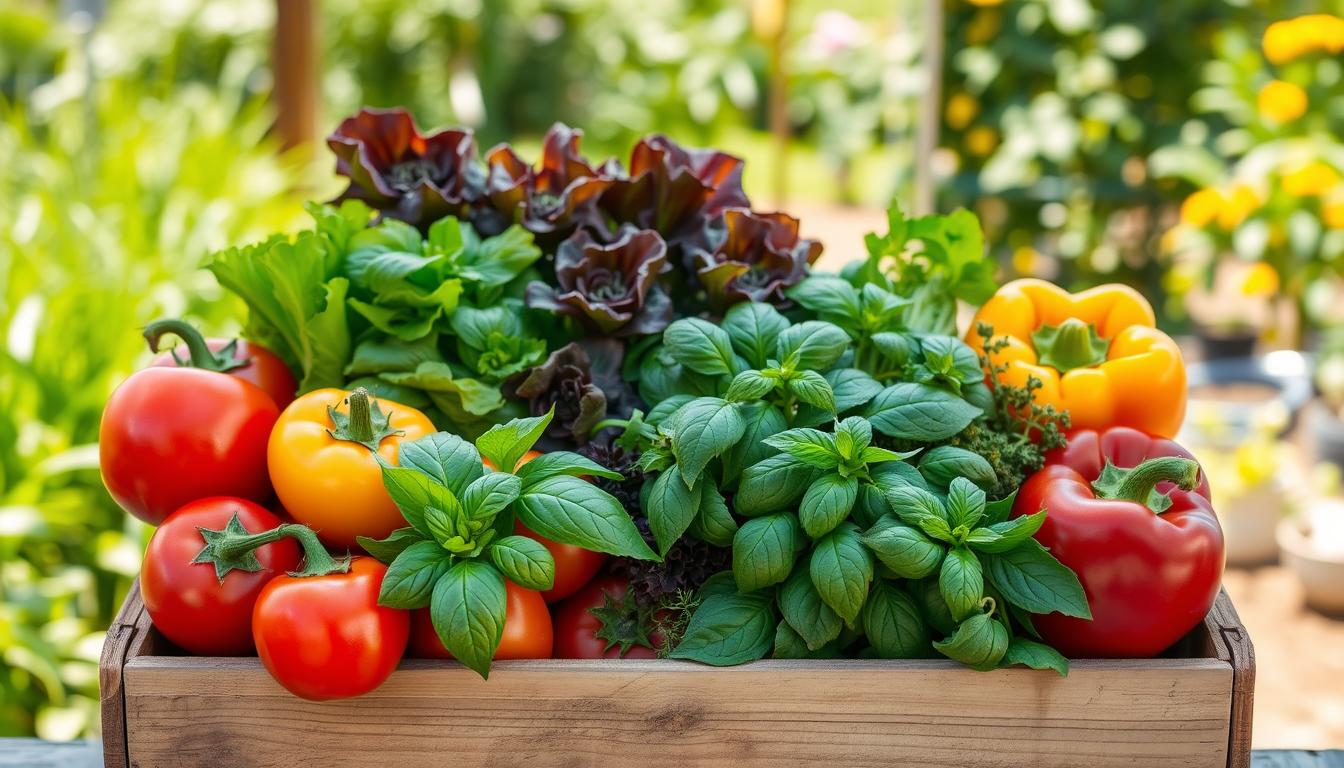This post contains affiliate links.
Ready to start a tasty journey in your backyard? Welcome to garden-to-table living! It’s time to get your hands dirty and grow your own food. From planting seeds to making delicious meals, this adventure connects you with nature.
Imagine eating a juicy tomato you grew yourself or making a salad with fresh greens. That’s the magic of garden-to-table living! You’ll enjoy the freshest flavors and join a community of home gardeners changing how we eat.
On this farm-to-fork adventure, you’ll learn about gardening. You’ll pick the right seeds and learn to compost. You’ll also find new ways to use seasonal produce and impress your friends with your cooking skills. Plus, you’ll know exactly where your food comes from.
So, are you ready to turn your backyard into a garden full of fresh produce? Get ready for a journey that will excite your taste buds, nourish your body, and maybe even make you the neighborhood’s top gardener!
Key Takeaways
- Experience the joy of growing and cooking your own food
- Learn practical gardening tips and harvesting techniques
- Discover creative ways to use seasonal, homegrown produce
- Connect deeply with nature through garden-to-table living
- Join the movement towards sustainable, hyperlocal food production
- Impress friends and family with fresh, homegrown ingredients
- Embrace the health benefits of farm-to-fork eating
The Magic of Garden-to-Table Living
Garden-to-table living is more than a trend. It’s a journey that changes how you see food. By living this way, you feed your body and help the planet. Let’s explore the joy of growing and eating your own food.
Connecting with Nature Through Food
Planting a seed and watching it grow connects you to nature. This connection changes how you cook and eat. You’ll look forward to the first ripe tomato or fresh basil, ready to make a tasty meal with your own hands.
Health Benefits of Fresh Produce
Homegrown fruits and veggies are packed with nutrients. Here are some numbers to show you:
| Nutrient | Homegrown (%) | Store-bought (%) |
|---|---|---|
| Vitamin C | 30 | 17 |
| Iron | 21 | 14 |
| Magnesium | 14 | 9 |
Eating fresh, nutrient-rich food boosts your health. Plus, growing your own food makes every meal more special.
Environmental Impact of Local Eating
The locavore movement and sustainable farming are key to garden-to-table living. By eating local, you reduce your carbon footprint and help the planet. It’s good for you and the Earth!
https://www.youtube.com/watch?v=R3LzK9e0Qyw
Start your garden-to-table journey. It will change your meals, health, and connection to the world. It’s time to enjoy the fruits (and veggies) of your labor!
Starting Your Own Garden: A Beginner’s Guide
Are you ready to start your urban farming and permaculture gardening journey? Growing your own garden is a rewarding experience. It connects you with nature and brings fresh food to your table. Let’s look at some key tips to help you get started!

First, think about your space. A 10′ x 10′ plot is great for beginners. If you have less room, raised beds (4′ x 4′ or 4′ x 8′) are perfect for urban farming. Most veggies need 6-8 hours of direct sun each day.
Soil preparation is key to success. Add a 2-3 inch layer of compost to enrich your soil. For a quick start, try the lasagna gardening method. It takes about four months for compost and paper to break down, making a nutrient-rich bed.
“Choose plants that match your space and climate. It’s the secret sauce of permaculture gardening!”
Now, let’s talk about plants. Here are some easy-to-grow veggies for beginners:
- Lettuce
- Green beans
- Tomatoes
- Zucchini
- Peppers
Water your seedlings every day, then reduce as they grow. Mulch helps keep moisture in and weeds out. With these tips, you’ll be enjoying your own fresh produce soon!
| Garden Type | Recommended Size | Ideal for |
|---|---|---|
| Ground Plot | 10′ x 10′ | Beginners with yard space |
| Raised Bed | 4′ x 4′ or 4′ x 8′ | Urban farming, limited space |
| Container Garden | Varies | Balconies, patios |
Seasonal Planting: Maximizing Your Harvest
Ready to make your backyard a year-round organic food paradise? Buckle up, green thumbs! We’re diving into seasonal planting, where sustainable agriculture meets your dinner plate.
Spring Planting Tips
As frost melts, wake up your garden. Start with cool-season crops like spinach, arugula, and kale. These plants thrive in cool weather, giving you an early start.
Summer Crop Management
Summer’s here, and your garden’s ready to party! Plant heat-loving veggies like tomatoes, peppers, and zucchini. Keep them happy with regular watering and organic mulch. For a continuous harvest, try succession planting – sow quick-growing crops every 7-14 days.
Fall Harvest Strategies
As leaves turn golden, your garden’s still strong. Plant cool-season crops again for a second harvest. Think lettuce, radishes, and peas. Pro tip: pair plants with different maturity dates to use your space well.
Winter Garden Preparation
Winter’s coming, but don’t stop gardening! Prep your beds with cover crops to enrich the soil. Plan next year’s layout, keeping crop rotation in mind for healthier plants and soil. Your sustainable agriculture journey doesn’t hibernate – it evolves!
“To plant a garden is to believe in tomorrow.” – Audrey Hepburn
Remember, a garden journal is your best friend in this seasonal dance. Track your plantings, harvests, and observations. Before you know it, you’ll be a master of organic food production, serving up garden-fresh meals year-round!
Essential Tools for the Garden-to-Table Enthusiast
Ready to dive into the garden-to-table lifestyle? You’ll need the right gear to get growing! From soil to plate, these tools will make your sustainable agriculture journey a breeze.

Let’s start with the basics. Every budding gardener needs gloves, a trowel, and a garden fork. Don’t forget heavy-duty shears and bypass pruners for those unruly plants. Keep some rubbing alcohol handy to clean your tools – cleanliness is next to gardenliness!
For the tech-savvy gardener, consider investing in a plant moisture meter. Terrain offers one for $24. It’s like a fitbit for your veggies! And if you’re short on space, check out Pottery Barn’s cedar 8-pocket herb garden bed at $199. It’s perfect for small-scale garden-to-table adventures.
Now, let’s talk storage. The West Elm steel canvas garden tote ($89) is perfect for lugging your tools around. And when the sun’s beating down, don’t forget to protect yourself with a stylish Cult Gaia Bijan sun hat ($248).
| Tool | Price | Use |
|---|---|---|
| Terrain Plant Moisture Meter | $24 | Soil moisture monitoring |
| Pottery Barn Cedar Herb Garden Bed | $199 | Compact herb growing |
| West Elm Steel Canvas Garden Tote | $89 | Tool storage and transport |
| Cult Gaia Bijan Sun Hat | $248 | Sun protection |
With these tools in your arsenal, you’ll be well-equipped to embrace the garden-to-table lifestyle. Happy planting!
From Soil to Plate: Harvesting at Peak Flavor
Harvesting your hyperlocal produce at the right time is key. It ensures you get the full flavor and nutritional benefits of organic food. Let’s explore the art of picking your homegrown goodies at their prime.
Identifying Ripe Produce
Knowing when your fruits and veggies are ready is crucial. Look for vibrant colors, firm textures, and enticing aromas. For example, tomatoes should be fully colored and slightly soft to touch. Cucumbers are best picked when they’re dark green and firm.
Proper Harvesting Techniques
Use clean, sharp tools to avoid damaging your plants. For leafy greens, cut outer leaves first, allowing inner ones to continue growing. When picking fruits like apples or pears, gently twist and pull upwards. This method ensures you don’t harm the tree or future harvests.
Post-Harvest Handling
Once picked, handle your organic food with care. Store root vegetables in a cool, dark place. Leafy greens stay fresh longer when refrigerated in a perforated plastic bag. Remember, your hyperlocal produce is at its nutritional peak right after harvest!
| Produce | Harvest Time | Storage Method |
|---|---|---|
| Tomatoes | Fully colored, slightly soft | Room temperature |
| Lettuce | Outer leaves 4-6 inches | Refrigerated, perforated bag |
| Carrots | 1-inch diameter | Cool, dark place |
By mastering these harvesting tips, you’ll enjoy the full benefits of your garden-to-table journey. Fresh, flavorful meals await!
Creative Cooking with Garden-Fresh Ingredients
Get creative in the kitchen with fresh ingredients from your garden! The farm-to-fork movement encourages us to use local produce. Garden-fresh ingredients make dishes taste amazing and are super healthy.
Try this garden tomato sauce recipe to enjoy summer flavors all year:
| Ingredient | Amount |
|---|---|
| Fresh tomatoes, chopped | 24 cups |
| Olive oil | 4 tablespoons |
| Garlic cloves | 8 |
| Red wine | 1/3 cup |
| Fresh herbs (thyme, parsley, oregano, basil) | To taste |
Cook tomatoes for 20 minutes, then add other ingredients and simmer. This sauce is great for big meals or canning. Add Parmesan rind, walnuts, or lentils for more flavor.
Explore the locavore movement with seasonal produce. Roast a mix of root vegetables at 425°F for 45-60 minutes. Sprinkle with cayenne or truffle oil for a boost. Sauté leafy greens with garlic, lemon, and sherry vinegar for a quick side.
“The farm-to-fork philosophy isn’t just about eating; it’s about connecting with your food and savoring every homegrown bite.”
Your dishes might even win contests! Try making buttery Monterey Jack cookies or maple apple crisp. Cooking with love and local ingredients opens up endless possibilities.
Preserving the Harvest: Canning, Freezing, and Drying
Embrace sustainable agriculture by preserving your organic food bounty! Enjoy garden-fresh flavors all year while reducing waste. Explore some nifty preservation techniques that will delight your taste buds and save your wallet.
Water Bath Canning Basics
Water bath canning is perfect for high-acid foods like tomatoes, jams, and pickles. It’s easy! Remember, altitude changes processing time. Add 5 minutes for every 1,000 feet above sea level. Properly canned foods can last up to a year or more. Always label and date your jars for future convenience.
Freezing Fruits and Vegetables
Freezing is great for keeping flavors and nutrients. For veggies, blanch in boiling water for 2-3 minutes, then ice water. This stops enzymes and keeps veggies fresh. Flash freezing is also cool: freeze a single layer of produce on a pan for 8-10 hours. Your future self will thank you!
Herb Drying Techniques
Drying herbs is an ancient method still loved today. It’s affordable and simple. Hang herbs upside down in a dark, dry place, or use a dehydrator. Once dry, crush and store in airtight containers. You’ll have flavorful, organic seasonings all year.
| Preservation Method | Best For | Storage Time |
|---|---|---|
| Water Bath Canning | High-acid foods (tomatoes, jams, pickles) | Up to 1 year |
| Freezing | Most fruits and vegetables | 6-12 months |
| Herb Drying | Herbs and spices | 1-3 years |
Garden-to-Table Entertaining: Hosting Memorable Meals
Hosting a farm-to-fork dinner party is a fun way to show off your fresh produce. Small farms and home gardeners are embracing this trend. They turn their harvests into festive gatherings that celebrate nature’s bounty.
Plan your menu with seasonal ingredients for the best taste and freshness. In summer, serve a steak salad at room temperature. For fall, decorate with corn, gourds, and apples. Winter parties can feature beets, parsnips, and potatoes.
Create a cozy atmosphere with these tips:
- Use propane heaters or fire pits for late-season outdoor dining
- Decorate with block print tablecloths and seasonal glassware
- Make DIY citronella candles as charming host gifts
Keep bugs away with essential oil repellents like citronella, geranium, and peppermint. Ask guests to bring dishes from their gardens. This adds variety and helps you relax.
The secret to a great garden party is celebrating the farm-to-fork journey. By sharing your hyperlocal produce, you’re not just serving food. You’re making memories that grow from nature’s bounty.
| Season | Menu Highlights | Decor Ideas |
|---|---|---|
| Summer | Steak salad, herb butter | Fresh flowers, lanterns |
| Fall | Roasted vegetables, apple desserts | Gourds, corn husks, mums |
| Winter | Root vegetable mash, chestnut creme brulee | Dried orange slices, eucalyptus, cedar fronds |
Embracing the Locavore Movement: Beyond Your Backyard
Ready to take your garden-to-table lifestyle to the next level? It’s time to dive into the locavore movement and explore beyond your backyard. You’ll be amazed at how this shift can change your eating habits and support your community.
Farmers’ Markets and CSAs
Farmers’ markets are booming, with a 16% increase in the U.S. between 2009 and 2010. These vibrant hubs offer fresh, seasonal produce and a chance to connect with local growers. Community supported agriculture (CSA) programs have also skyrocketed, growing from just 60 in 1990 to 3,600 in mid-2010. By joining a CSA, you get a share of farm-fresh goodies while supporting local agriculture.
Community Gardens and Urban Farming
Urban farming is taking root in cities across the country. These green oases not only provide fresh produce but also foster community spirit. You can join a community garden or start your own urban farm. It’s a great way to grow food, make friends, and green up your neighborhood.
Supporting Local Restaurants and Producers
Eating out? Choose restaurants that prioritize local ingredients. You’ll savor fresher flavors while supporting both local farmers and chefs. Many eateries now proudly list their local suppliers, making it easy to eat local even when dining out.
| Local Food Initiative | Growth | Impact |
|---|---|---|
| Farmers’ Markets | 16% increase (2009-2010) | Fresh produce, direct farmer interaction |
| CSA Programs | 60 to 3,600 (1990-2010) | Guaranteed farm income, consumer connection |
| Urban Farming | Growing trend | Community building, green spaces |
By embracing these local food initiatives, you’re not just feeding yourself – you’re nourishing your community and supporting a more sustainable food system. So go ahead, take that first bite into the locavore lifestyle!
Conclusion
You’ve started a tasty journey into garden-to-table living. It’s been an amazing trip! From planting your first seeds to enjoying that fresh tomato, you’ve seen the beauty of sustainable farming. Your green thumb not only feeds you but also helps the planet.
By joining the locavore movement, you’re cutting down on carbon and improving your health. Homegrown veggies are full of nutrients and less chemicals than store-bought ones. You’ll also save money, which is a win-win for you and the Earth.
Keep growing, digging, and cooking! Your garden-to-table journey is more than a hobby. It connects you to nature, your community, and your food. Whether you share with neighbors or try new recipes, you’re part of a delicious change. Now, let your garden flourish!
FAQ
What is garden-to-table living, and why is it important?
How can I start my own garden for garden-to-table living?
What are the benefits of eating homegrown, organic produce?
How can I extend the life of my garden’s harvest?
What are some creative ways to use garden-fresh ingredients in cooking?
How can I get involved in the locavore movement beyond my backyard?
What tools and equipment are essential for successful garden-to-table living?
This post contains affiliate links.

